|
|
 |
| |
●The Kippu-iri (preliminary meeting) and the Building of the Hoko and Yama Floats
On the 1st of July, the festival officials of Yamaboko-machi (Yamaboko parade route) hold a meeting called the "Kippu-iri" to arrange the details of the festival. This meeting marks the start of the festival. On the 2nd of July, the "Kujitori-shiki" is held at Kyoto City Hall to determine the order of the floats in the parade on July 17th. On July 10th, after the "Omukae-chouchin" (Paper lantern reception) and "Mikoshi-arai" (Ceremony to wash the Mikoshi or portable shrine), there is a purification ceremony for the Yasaka Shrine Mikoshi held on the Shijo St. Bridge (a similar "Mikoshi-araishiki" rite is also held on the 28th). Also on July 10th, the "Hoko-tate" (construction of the massive, two-storied floats complete with a standing pole topped with a unique ornament) and "Yama-tate" (construction of the smaller, mastless floats) are initiated. Float construction is finished by July 12th and each undergoes a trial run known as "Hiki-zome" in which these newly created floats go through pull tests to ensure that they are ready for the parade. On the 13th, there is a rite held called the "Naginata-boko Chigo-shasan" where the child chosen to ride on the Naginata-boko float in the festival procession visits the shrine. These floats that carry children and other passengers such as musicians are known as "Hoko" floats and have the long mast-like pole extending from the top. The smaller floats with pine columns and no riders are known as "Yama" floats. It is important to note that the "Kitakannon-yama" and "Iwato-yama" floats are considered "Yama" floats despite tall poles extending from their carriages, and another float decorated with traditional umbrellas (known as "Ayagasa-hoko") is considered a "Hoko" float. |
|
| |
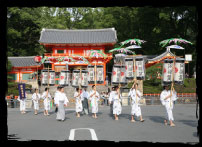 |
|
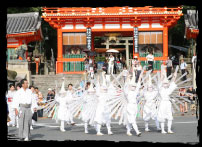 |
 |
| Paper Lantern Reception |
|
Paper Lantern Reception |
|
|
| |
●Yoi-yama
Kon-kon chiki-chin, kon-kon chiki-chin… that is the sound of Gion Matsuri. The days leading up to the grand parade are named like a countdown, with the 14th, 15th, and 16th being named "Yoi-yoi-yoi-yama," "Yoi-yoi-yama," and "Yoi-yama" respectively. On the Yamaboko-machi parade route, musicians sit atop still floats and paper lanterns are lit, producing a scene known as Giogayashi. Here you can see the folding screens in the homes along the Yamaboko-machi parade route and obtain chimaki (talismans in the shape of cakes wrapped in bamboo leaves) or special charms for success in school etc. from each of the floats (the cake-shaped talismans are not edible). Every night over these 3 days, thousands of people from all over the country gather in Gion to take part in the bustle of the Gion Matsuri.
| Material supplied by the Kyoto Newspaper |
|
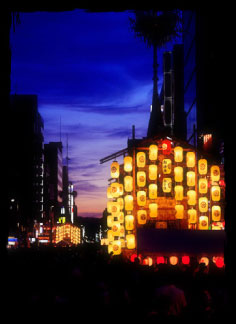 |
 |
| Yoi-yama |
|
|
| |
●Yamaboko Procession (national important intangible ethnic cultural property)
Held on the 17th of July, the Yamaboko Procession is the climax of the Gion Matsuri. A total of 32 floats (9 Hokos and 23 Yamas, 29 of which are specified as national important intangible ethnic cultural properties) are led by the Naginata-boko float to form a dazzling and gorgeous procession down the main streets of Kyoto. Music is supplied by musicians riding on the "Hoko" floats and accompanies the procession from the intersection of Shijo-Karasuma St. to Kawaramachi St., then north up Kawaramachi St. to Oike St. During the procession, there are several rites which take place, such as the "Shimenawa-kiri," (a ceremony in which the child riding the Naginata-boko float cuts the main thatch rope with a sword symbolizing the breakthrough of the border of the guardian deity's realm at Fuya-cho on Shijo St.), the "Kuji-aratame" ceremony held at Shijo Sakai-machi (a ceremony in which the mayor of Kyoto confirms the order of the procession), and the "Tsuji-mawashi," held at Shijo Kawaramachi (one of the main events of the procession where the floats turn 90 degrees at the corner intersection of Shijo and Kawaramachi streets, drawing loud applause and cheers from the gathered crowds).
| Material supplied by the Kyoto Newspaper |
|
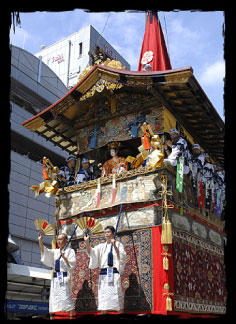 |
 |
| Yamaboko Procession |
|
|
| |
●Shinkosai Ceremony - Mikoshi Togyo Procession - Kankosai Ceremony
After the Yamaboko Procession is over on the evening of the 17th, some of the spirit of the guardian deity of Yasaka Shrine is divided into three Mikoshi portable shrines in a ceremony known as Shinkosai, which is performed at the main hall. The shared deity is then carried via Mikoshi portable shrine to Shijo Otabi-sho in what is known as the Mikoshi Togyo procession. On the 24th of July, the Kankosai Ceremony is the return of the three Mikoshi portable shrines to Yasaka Shrine. |
|
| |
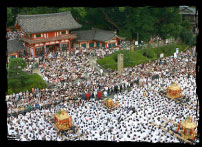 |
|
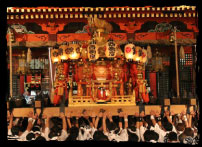 |
 |
Shinkosai Ceremony –
The event begins at the bottom of the stone steps
Three Mikoshi Portable Shrines
(Naka Oza, Higashi Oza, Nishi Oza) |
|
Kankosai Ceremony -
Nishi Oza (Nishiki-shinyokai) |
|
|
| |
●Hanagasa Procession
In the past, the Yamaboko Procession (held on the 17th) and the Ato-no-matsuri (literally "after the procession", held on the 24th) were celebrated as separate events. However, in 1966 the Ato-no-matsuri was also held on the 17th, and in order to reproduce the old form of the events, the Hanagasa Procession was held on the 24th. Led by the children’s Mikoshi, there are 10 Hanagasa floats and warriors in the procession with a total of about 1,000 people, including Sagiodori dancers, lion dancers, and floats with geisha and maiko onboard. The procession leaves Yasaka Shrine and goes down Shijo St., Kawaramachi St., Oike St., and Teramachi St. before returning via Shijo St. to arrive back at Yasaka Shrine. |
|
| |
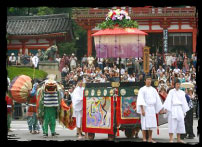 |
|
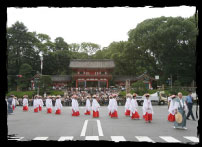 |
 |
| Hanagasa Procession |
|
Hanagasa Procession |
|
|
|

